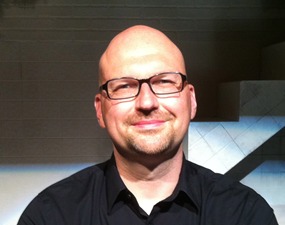
22 Apr Cross Cultural Collaboration- Bringing Communique n˚10 from Des VoixReading to Full Production! A blog by Rob Melrose
Cutting Ball Theater is proud to present the American Premiere of Communiqué n˚ 10 as a part of Des Voix… Biennial 2014 A Festival of Contemporary French Plays and Cinema. This is only the second production of this play (the first was in Avignon in the original French) and it is the first production of a Samuel Gallet play in the United States. Communiqué n˚10 was part of the Des Voix… Found in Translation 2012, and was directed and translated by Rob Melrose during the staged reading process.

Rob Melrose
We asked Rob Melrose, Cutting Ball Theater Artistic Director, to share his thoughts and relationship with Communiqué n˚10 throughout the past few years. Enjoy!
As part of the selection team for the inaugural festival of Des Voix – a week of readings of new French plays in translation – I fell in love with Communiqué n˚ 10’s craft and composition: a powerful combination of short, cut to the bone scenes and long, luxurious Faulknerian monologues that penetrate deeply into the minds and memories of Gallet’s characters. Only after reading did I learn that the play was inspired by the 2005 riots outside of Paris by disaffected North African youth. Gallet had managed to create specific characters but has also abstracted the landscape so that the story felt universal and essential as opposed to “ripped from the headlines.”
Through directing the reading for Des Voix, I realized that the play actually resonates with life in our theater’s neighborhood – the Tenderloin – where we have such an important immigrant population. At about the same time as the first Des Voix Festival in 2012, Occupy Wall Street started and Romney commented about “the 47%”; it seemed like everyday some piece of news highlighted our country’s growing divide between rich and poor. At The Cutting Ball Theater, just blocks from Market Street, we feel the difference between longtime Tenderloin residents and the boom of tech companies moving in. Now feels like a perfect time to present a play that examines, with such humanity and care, the insurmountable gulf between haves and have-nots.
This play has been the most challenging translation project of my career thus far. I have translated works by Sartre, Arrabal, Maeterlinck, and Ionesco…none of them a walk in the park, to be sure. What makes Samuel’s play so challenging is that he not only writes in the hurried French of the streets, but he also writes in a heightened poetic language that is surprising and strange. The characters speak in ways that would sound artfully unnatural to a modern French audience. This meant that after I took one pass through the play just making sure I had decoded the colloquial expressions so that I had the sense correct, I had to do another pass to make sure I was riding the right line between naturalism and non-naturalism in a way that retained the poetic spirit of the language and still felt like people talking to each other.
Gallet’s world may feel like a post-apocalyptic inner city to us. But unlike U.S. cities (with the possible exception of Manhattan) in France, the marginalized people live outside the city in the suburbs (la banlieue) and the wealthy live in the center of the city. So to translate la banlieue as “suburbs” would give the completely wrong impression. Another word I am struggled with was friches. It is a word that means industrial wasteland – abandoned buildings, factories and warehouses. We don’t have a simple single syllable word for this (even a single word for this – forget the syllables). I struggled with it because it is a very important word in the play – much of it takes place in les friches. “Wasteland” by itself has a poetic resonance with us in English and that is what I am favored now, hoping that in our full production, the industrial-ness of the wasteland will be implied.
As gritty as the world of the play is, the language in it is rich and resonant – it is as if the characters are speaking from soul to soul, revealing their innermost thoughts and needs. In this way Gallet is an heir to Beckett, to Pinter, to Bernard-Marie Koltès, and to Sarah Kane. His language is simple and at the same time profound. It is an extraordinary play and it has been a great privilege to work on it.
As our Cutting Ball audience knows well, Associate Artistic Director Paige Rogers and I have been in love with European theater for years, and recently have developed a particularly strong love for the theater of Poland, which really came into its own with the work of Jerzy Grotowski after the Second World War decimated Poland. Out of the ashes, Grotowski created what he called a “poor theater.” Opera composer Richard Wagner dreamed of a rich theater experience where all the arts (dance, music, painting, theater) could come together in what he called a “gesamtkunstwerk” (literally a “total art work”). Grotowski, on the other hand, pondered a theater made of little more than the actors and the audience – a theater stripped-down to its essence, that focuses on the actor’s work. It is a physical, muscular theater. Paige and I have now been to a number of festivals there and Grotowski’s spirit still infuses everything we see. Some props are mimed, some aren’t, sometimes there’s a set, sometimes just a skeletal structure – but the work of the actor is at the center. In a world where digital animation can represent anything the mind can imagine in film, seeing theater in Poland that takes full advantage of our art form’s strengths is truly refreshing.
It is this focus on the actor’s flesh and blood presence and physical work that I wanted to bring out in our production. On this production, I feel fortunate to be working with with Emma Jaster, who choreographed the physical moments and trained the actors in some of her many physical vocabularies. (Emma and I had the same commedia dell’arte teacher – it is indeed a small world.) This physical work adds a layer that becomes as important as the text itself.
The actor / audience relationship is extremely important in Grotowski’s theater and many of his productions redesigned the space anew for each play giving the audience a new vantage point on the actor. For Communiqué n˚ 10, I thought it would be powerful to have the audience on either side of the action on the same level with the actors. Today, when so much of our communication occurs online, having a configuration that emphasizes the physical presence of the actors and our fellow audience members highlights what is special in a theater experience.
At the same time as I am directing Communiqué n˚ 10, I am in the process of translating another contemporary French play for the second incarnation of Des Voix, Riad Ghami’s When and Where We Died(Où et Quand Nous Sommes Morts). While Gallet’s play takes us deep inside the French banlieues to follow an Arab immigrant as he seeks revenge for his slain brother, Ghami’s play takes us into an upper-class apartment of a wealthy couple being invaded by a young Arab man.
In many ways Where and When We Died and Communiqué n˚ 10 try to get at the same problem through completely opposite perspectives. From Ghami’s biting satire to Gallet’s poignant tragedy, from the extremely privileged world of When and Where We Died, to the gritty wastelands of Communiqué n˚ 10, these plays have a lot to say to one another and cover a great deal of ground. It is this kind of thematic connection that makes a festival like Des Voix so rich and I eagerly anticipate hearing about the experiences of the audience members who chose to experience the work of both writers!
-Rob Melrose, Artistic Director of Cutting Ball Theater and Des Voix Translator and Director


No Comments